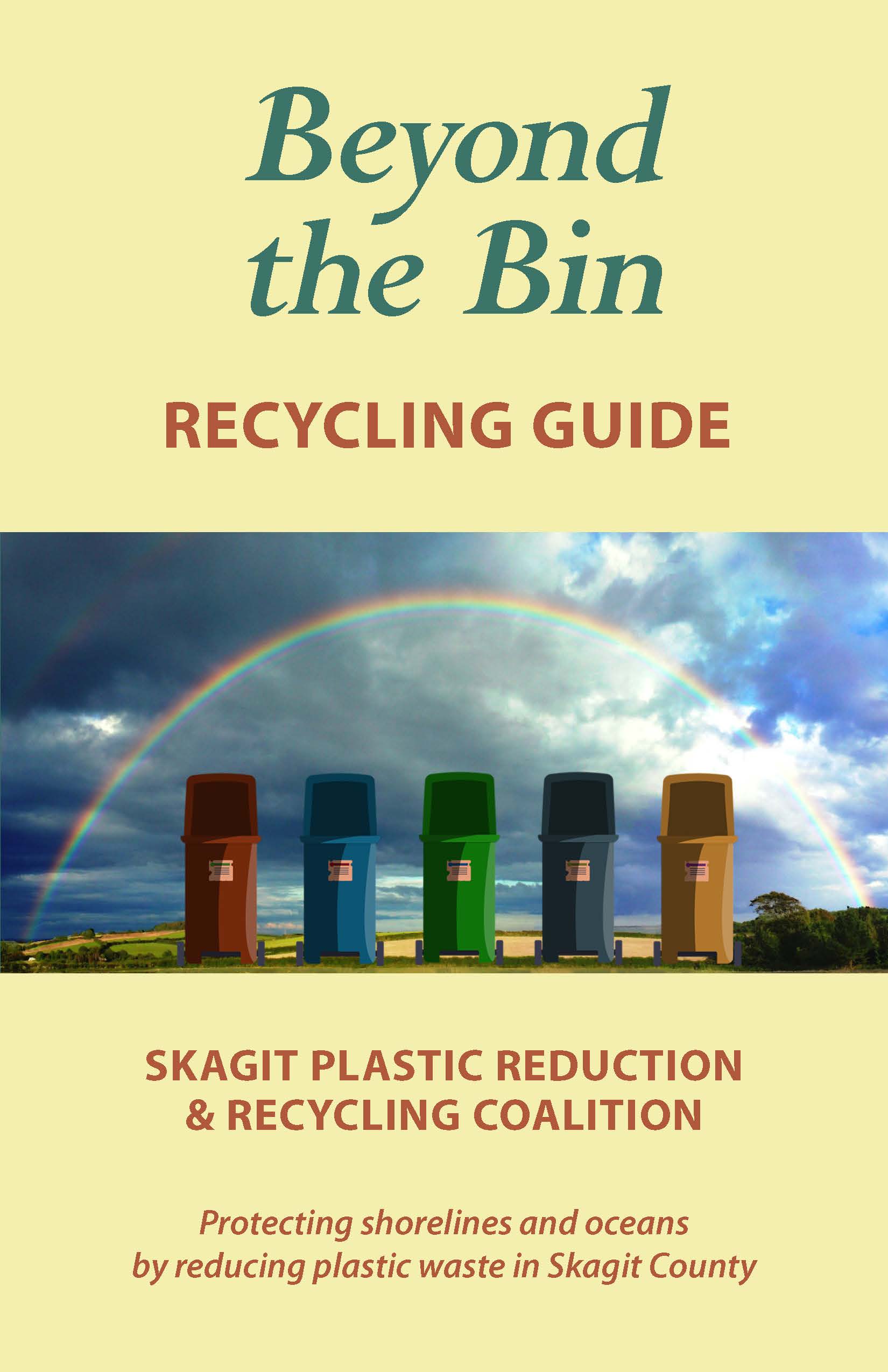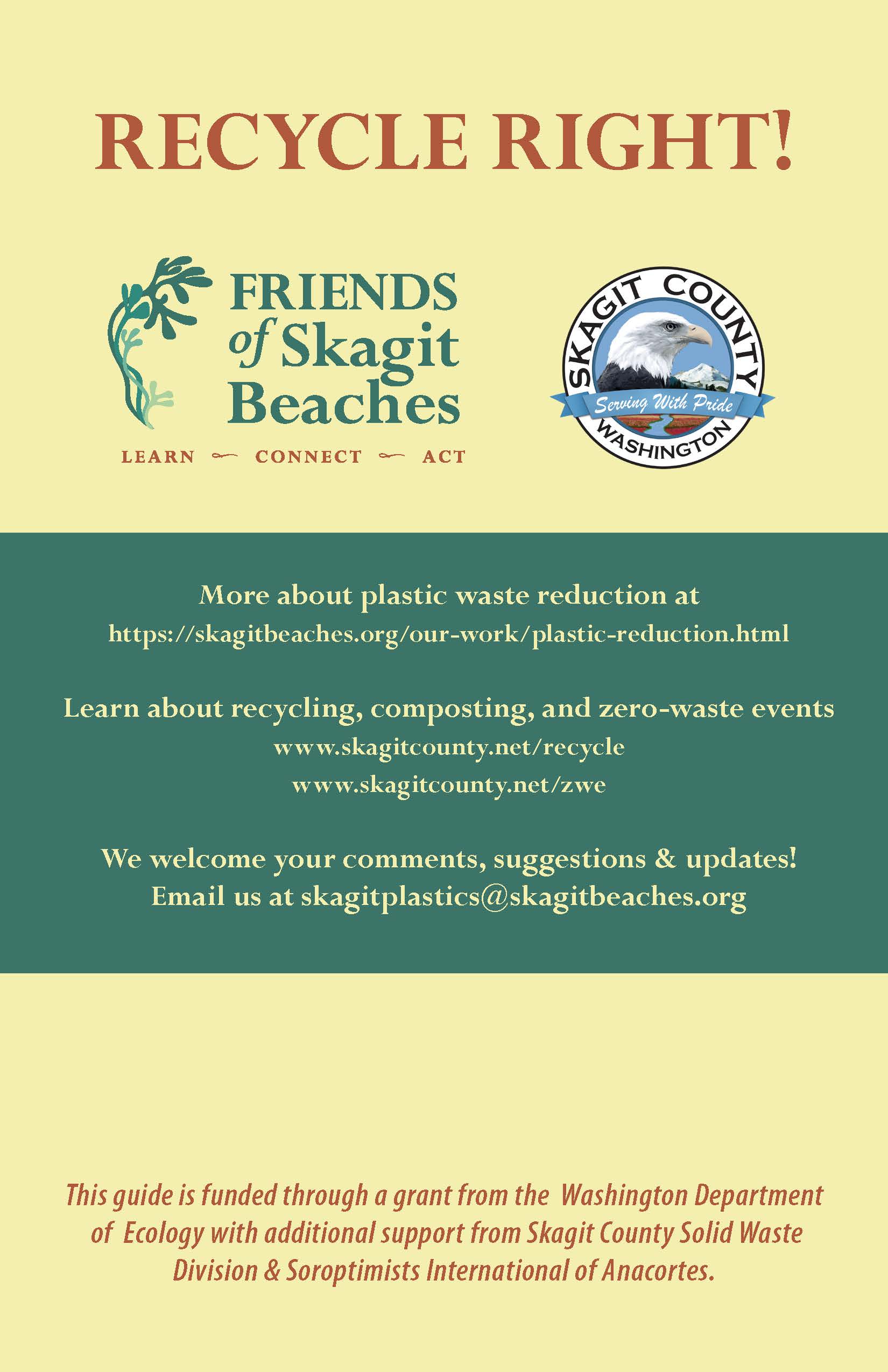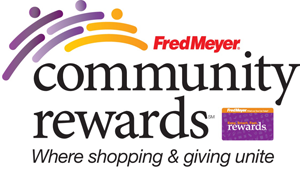|
Friends Notes
Plastic pollution and its impacts on the marine environment is an important issue that seems to be in the news a lot lately.
Crafted, created, and led by board member Betty Carteret, Friends of Skagit Beaches’ newest project, Skagit Plastic Reduction and Recycling Coalition (SPRRC) received a $30,000 from the Department of Ecology in September 2018.
The objectives of the project:
- Raise awareness about harmful impacts of plastic waste
- Reduce the use of single-use plastics
- Promote lifestyle choices that will reduce harmful impacts of plastic waste
- Reduce contamination of the plastic recycling waste stream
Right out of the starting gate, the project established a working partnership with Skagit County Solid Waste Division. Callie Martin, Skagit County’s outreach specialist for waste reduction and recycling has provided insights, valuable information, and resources.
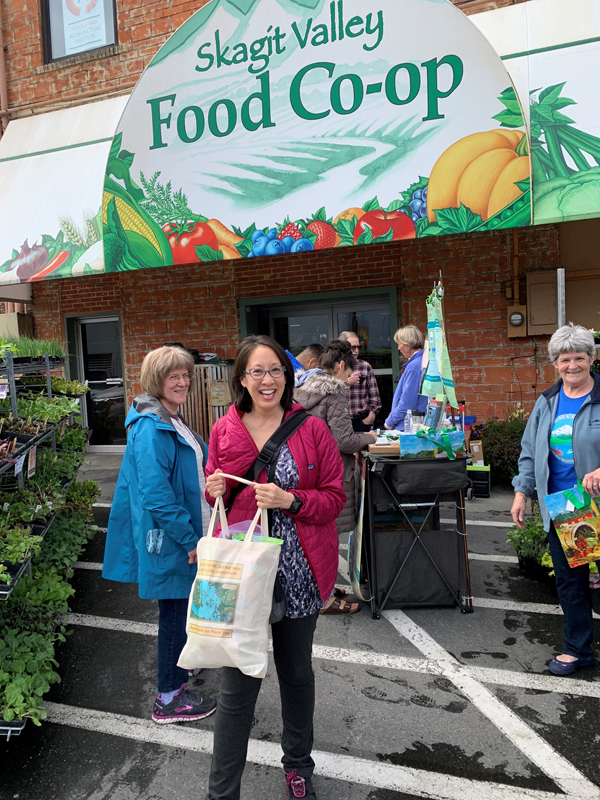 Volunteer participation in the project exceeded expectations by more than double the 450 hours proposed in the grant application. As of the end of the grant period on June 30th volunteers had given over 1,000 hours of service to the project!
Volunteer participation in the project exceeded expectations by more than double the 450 hours proposed in the grant application. As of the end of the grant period on June 30th volunteers had given over 1,000 hours of service to the project!
Over 1,300 community members were contacted and over 800 plastic reduction pledges have been completed. Pledge participants were sent a survey and results indicate that the messages shared in our outreach are making a difference and people are making positive changes to reduce their use of single-use plastics and also following guidelines for recycling more carefully.
Check out our other blog posts and the Plastic Initiative section to learn more about this project, plastic and what you can do to make a difference.
Would you like to get involved?
Contact Betty at: This email address is being protected from spambots. You need JavaScript enabled to view it.
 It was a cool mostly cloudy 4th of July morning when Pete Haase, Tom Flanagan, and I met at the March Point Park and Ride. Pete and I are members of the Fidalgo Bay Aquatic Reserve (FBAR) Citizen Stewardship Committee (CSC) and Tom is a super volunteer/citizen scientist. We were headed to Libbey Beach Park, a small Island County park just north of Fort Ebey State Park on the western shores of Whidbey Island. It is part of the Smith and Minor Island Aquatic Reserve (SMIAR), an area that spans 36,300 acres of tidelands and seafloor habitat and includes the largest bull kelp forest in the State of Washington.
It was a cool mostly cloudy 4th of July morning when Pete Haase, Tom Flanagan, and I met at the March Point Park and Ride. Pete and I are members of the Fidalgo Bay Aquatic Reserve (FBAR) Citizen Stewardship Committee (CSC) and Tom is a super volunteer/citizen scientist. We were headed to Libbey Beach Park, a small Island County park just north of Fort Ebey State Park on the western shores of Whidbey Island. It is part of the Smith and Minor Island Aquatic Reserve (SMIAR), an area that spans 36,300 acres of tidelands and seafloor habitat and includes the largest bull kelp forest in the State of Washington.
Today we were doing what any red blooded old white guys do on the Fourth of July, we were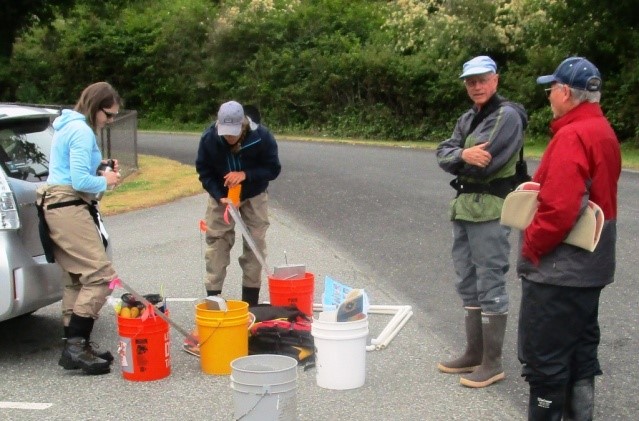 going to help a couple of young ladies, Jamie Kilgo and Cassidy Johnson from the Department of Natural Resources (DNR), with a kelp harvesting study. Pretty much what everybody does on the 4th of July, right? The goal of their study is to gather information about harvester practices and evaluate potential impacts of harvesting on the intertidal kelp community. Kelp is a broad term used to describe a group of brown macroalgae species common to our Salish Sea rocky shores, including the iconic bull kelp (Nereocystis leutkeana). Kelp forests, as they are known, are extensive underwater (most of the time) “factories” that convert solar energy into food and protective structure for many of its inhabitants, like invertebrates and fish, including juvenile salmonids. They are vital to a healthy intertidal and subtidal ecosystem.
going to help a couple of young ladies, Jamie Kilgo and Cassidy Johnson from the Department of Natural Resources (DNR), with a kelp harvesting study. Pretty much what everybody does on the 4th of July, right? The goal of their study is to gather information about harvester practices and evaluate potential impacts of harvesting on the intertidal kelp community. Kelp is a broad term used to describe a group of brown macroalgae species common to our Salish Sea rocky shores, including the iconic bull kelp (Nereocystis leutkeana). Kelp forests, as they are known, are extensive underwater (most of the time) “factories” that convert solar energy into food and protective structure for many of its inhabitants, like invertebrates and fish, including juvenile salmonids. They are vital to a healthy intertidal and subtidal ecosystem.
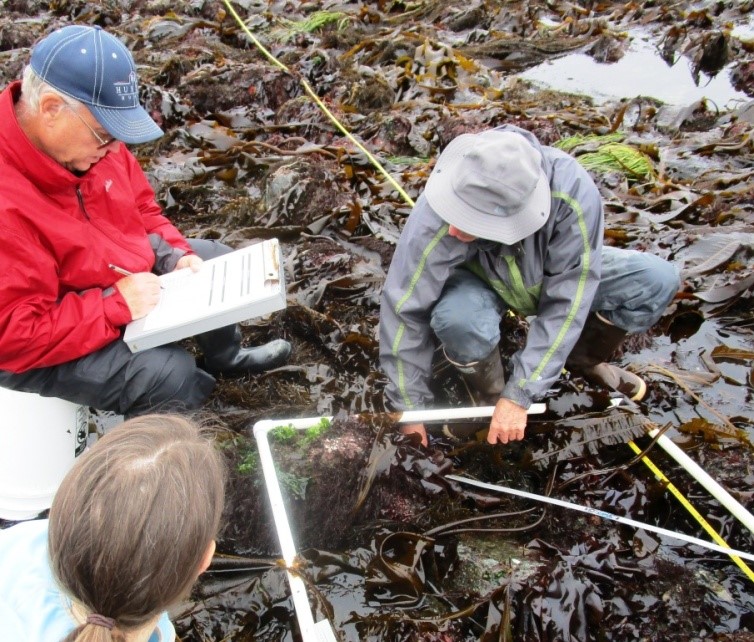 Although Tom and I are experienced citizen scientists, neither of us had experience with these types of studies. We are both former engineers so almost impossible to train! Pete was an “old hand” having been out on the beach with Dale Fournier, FBARCSC member, and Jamie a few weeks earlier. By some miracle, Jamie and Cassidy were able to quickly teach us (the tide would soon be coming back in!) how to identify, measure, and record data on these amazing macroalgae in a very short time. Proof that you can teach an old dog new tricks!
Although Tom and I are experienced citizen scientists, neither of us had experience with these types of studies. We are both former engineers so almost impossible to train! Pete was an “old hand” having been out on the beach with Dale Fournier, FBARCSC member, and Jamie a few weeks earlier. By some miracle, Jamie and Cassidy were able to quickly teach us (the tide would soon be coming back in!) how to identify, measure, and record data on these amazing macroalgae in a very short time. Proof that you can teach an old dog new tricks!
Although we were noting and recording the presence of several types of kelp, our focus was on Alaria marginata (winged kelp) and Saccharina spp. (sugar and split leaf kelp). These species are the preferred targets for the recreational harvesters.
One of the things that makes the beaches along the west side of Whidbey perfect for supporting large kelp beds but extremely difficult to walk (better to crawl!) are the large boulders that litter the beach. Kelp attaches and anchors itself to the rocks so as not to be swept away by winter storms or strong tides. Once anchored solidly to the sea floor, the kelp forests absorb significant amounts of wave energy thereby slowing beach erosion.
These studies actually started back in 2015 when members of SMIAR and other local environmental groups began observing and recording spatial and temporal harvester patterns, measuring the wet weight of harvester buckets, and conducting harvester interviews at Libbey Beach. Since 2017, the DNR led by Jamie Kilgo and her team, has been conducting a harvest method impact study.
One of the outgrowths of the work by volunteers and DNR is a harvester outreach and education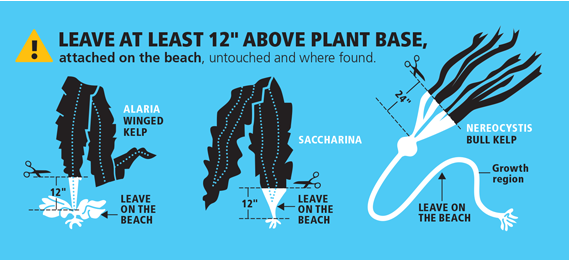 program. Interpretative signs were developed and installed a few years ago. Harvesters are provided information on the best method to harvest kelp so that it can survive and re-grow. It turns out the methods used to harvest kelp are critical to sustainability. If the stem is cut too close (generally less than 12”) to the holdfast, it is not able to regenerate and/or reproduce. Not a good thing if we want sustainable kelp forests!
program. Interpretative signs were developed and installed a few years ago. Harvesters are provided information on the best method to harvest kelp so that it can survive and re-grow. It turns out the methods used to harvest kelp are critical to sustainability. If the stem is cut too close (generally less than 12”) to the holdfast, it is not able to regenerate and/or reproduce. Not a good thing if we want sustainable kelp forests!
As we finished up and headed home for a “normal” 4th celebration, it reminded me that the actions taken by a small group of engaged local citizens can make a big difference toward protecting our rich marine environment.

Our volunteers share their best strategies for reducing single-use plastic
Okay, you’ve taken the Plastics Pledge and, according to our survey results, you’re doing a pretty darn good job of reducing single-use plastics and improving recycling. You’re working hard to adopt the four major Simple Swaps:
- Swap out that single-use bottled water by bringing your own reusable water bottle
- Swap out that plastic grocery bag by bringing your own grocery totes to the store
- Swap out that plastic cutlery by bringing your own reusable cutlery when you eat on the go
- Swap out that single-use coffee cup and plastic lid by bringing your own reusable coffee mug
Now, let’s think about taking the challenge a bit farther. Let’s swap out some of the single-use plastic in our lives that are a little less obvious.
First, identify a couple single-use plastic items you tend to use a lot. Do you eat a lot of single-serving yogurt? Do you buy single-serving chips for school lunches? How about those plastic produce bags at the grocery store? Pick the thing that you use most and figure out how to swap it out for a non-plastic or reusable option.
We asked our many volunteers who you’ve met around the County hosting our interpretive display to tell us what single-use plastic items they use and what they do to reduce their use. Some of their ideas might just fit your lifestyle, too!
Bulk up on bulk foods! The most frequent answer to the question of what single-use plastic you use the most is, as predicted, food packaging. How to avoid all those tubs and plastic jars? Lots of our volunteers buy in bulk. Dale buys spices, nuts, and beans in bulk. Linda buys her tea in bulk. Ellen buys nut butters in bulk. And she buys blocks of parmesan cheese and grates it herself. And Mae buys dried milk instead of milk in plastic containers.
And don’t forget those cleaning supplies and soaps. Maureen buys those in bulk, too! And in the ‘every bit counts department,’ Joan considers dental floss a triumph of packaging over product, so she buys her dental floss in big dispensers.
And bring your own containers. Those plastic produce bags are easily swapped out for mesh bags available for purchase. Craig brings his own cotton bags for bulk items, too. Some stores allow and even reward you for bringing your own containers to buy their bulk products. Linda reports that the Vinegar and Oil store gives you credit for reusing glass bottles.
Speaking of yogurt, Betty has eliminated those single-serving tubs by making her own yogurt in her Instant-pot. Some of our other volunteers have been resurrecting their latent kitchen talents, too. Dale makes her own guacamole and salsa. Maureen and Betty make their own hummus (recipe below). Ellen makes her own salad dressing. Heidi makes her own crackers and granola. And Susan bakes her own bread. And how about using real lemons and limes instead of those little plastic fruit replicas?
And whatever happened to glass? If you must buy packaged goods, look for glass containers, or paper packaged products to avoid plastics. Some products that are still readily available in glass or paper are salad dressing, pasta sauce, honey, wine (thank goodness), bar soap, vinegars, and soy sauce.
But its summertime and what about all those plastic plant pots? They are NOT RECYCLABLE as you know, so don’t put them in your recycling bins. Ruth reports that Sanitary Service Center in Bellingham does take them to recycle. But you have to drop them off there. If you can’t reuse them yourself, Jan reports that Master Gardeners and Native Plant Society have a bin in the parking lot of the Mount Vernon Extension Center for large size, square pots. You can avoid them entirely by buying plants bare root or in plugs. Joe’s Garden in Bellingham sells some plugs of vegetables. And, of course, you can start your plants from seeds yourself.
That’s not all! Do you have some great ideas to help us all reduce our use of single-use plastic? We’d love to hear them. Comment below or send us an email at This email address is being protected from spambots. You need JavaScript enabled to view it.. And look for us at local Farmers Markets this summer. Stop by to say hi and share your simple swap ideas!
Easy Homemade Hummus
Got 10 minutes? Get out that food processor hiding in the cabinet. This recipe can be adapted to your own tastes by adding more/less of some ingredients and topping with your favorite additions such as roasted garlic, pine nuts, roasted peppers, or whatever suits your fancy. Enjoy and pat yourself on the back for not buying that plastic container in the store.
2 to 4 garlic cloves to taste
¼ cup water; additional to thin at end to taste
¾ cup tahini
¼ cup fresh lemon juice, ~ 1 large lemon or 2 small
1 teaspoon salt (substitute garlic salt if you love garlic)
¼ cup ground cumin
15.5 ounce or ~1¾ cup chickpeas, rinsed and drained
Add garlic cloves to food processor and pulse until minced. Add ¼ cup water, tahini, lemon juice, salt, and cumin. Puree for about one minute until texture becomes light and smooth (pourable, not thick and pasty). Add chickpeas and puree three minutes until very smooth. You can add more water by the tablespoon to thin the consistency as you like. Store in refrigerator in sealed container for one week.
******
The Skagit Plastic Reduction and Recycling Coalition is a partnership between Friends of Skagit Beaches, Skagit County Solid Waste, and the Washington Department of Ecology. We are working to educate Skagit County residents on the issues of plastic waste in the environment and involve them in taking action to avoid single-use plastics and recycle plastic right.
The Friends of Skagit Beaches Plastics Project is funded by a grant from the Washington Department of Ecology with additional support from Skagit County Solid Waste Division.
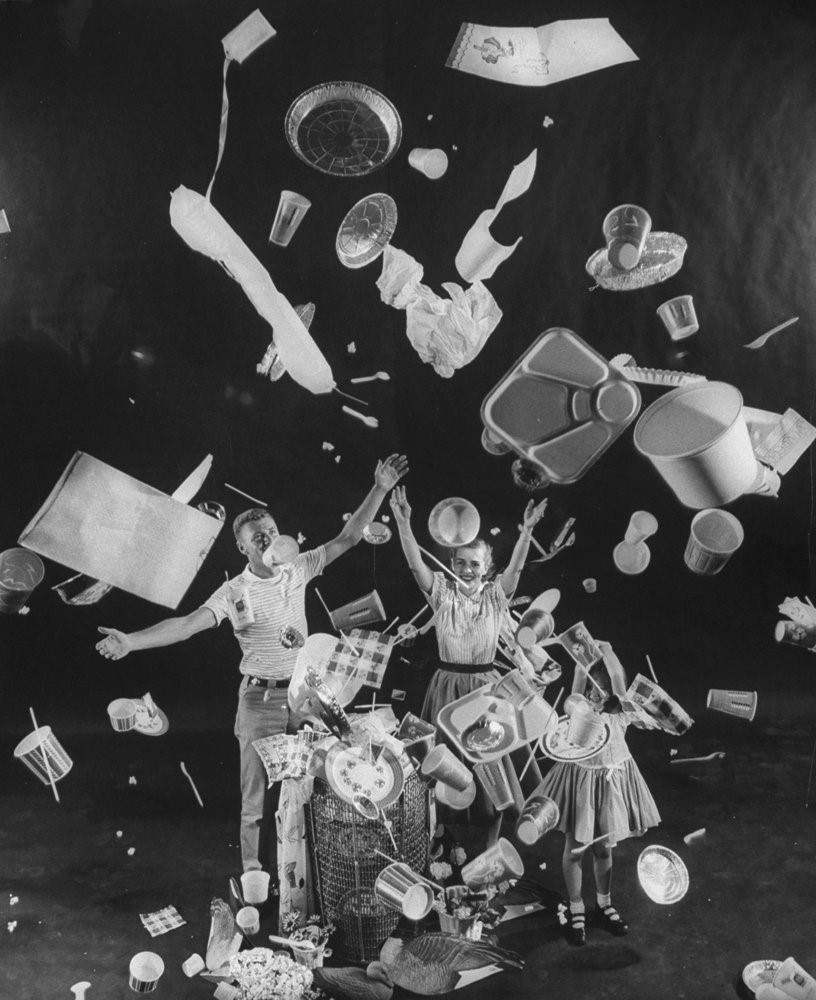
Its kind of a love/hate relationship we have with plastics
Plastic is an amazing thing. Invented in 1907 and perfected during the first half of the 20th century, plastic hit the market in full force in the post WWII era. The photo above from a 1950s Life Magazine article touted the advent of “Throw-Away” living and promised how it would free us from the burden of household chores. Plastic is durable, cheap, stain resistant, and light. We use it in so many ways, from airplanes to eyeglasses. Its durability is one of plastic’s attractions, but it also causes some serious problems related to disposal. That “Throw-Away” lifestyle has come at a significant cost to the environment and health.
By the Numbers. It is said that every piece of plastic ever made still exists on the planet today. An estimated 6,300 million metric tonnes, or 90.5% of all plastic waste ever manufactured, has never been recycled. Americans only recycle about 9% of the plastics used. Whereas in Europe, the plastic recycling rate is 30%. This unrecycled plastic has ended up in landfills, incinerators, or floating free and polluting the environment. All that plastic will last long after its useful life has ended. It takes 450 years for a plastic bottle to decompose in a landfill.
More numbers, because we love them. And it takes a lot of energy to make all the plastic we use. In the US plastic manufacturing consumes 12 million barrels of oil each year in the production of 30 billion plastic bags. Between 8-10% of the nation’s oil supply is used during the manufacturing process of plastics and it is predicted that plastics production will consume 20% of the world’s oil production by the year 2050. Nearly half of the 400 million tons of plastic produced worldwide each year is destined for single use items (e.g., straws, cups, bottles, bags) that have an average useful life of only 10-15 minutes before they become part of the waste stream. For example, single use plastic bags like those from the grocery store are only used for an average of 12 minutes!
Plastic in the oceans. 8 million metric tons of plastic waste flows into the oceans every year. 80% of the plastic waste entering the oceans is from land-based sources, washed into the ocean after it is washed into rivers and streams. Plastic released at sea from fishing, shipping, and other maritime activities accounts for only 20% of the plastic entering the ocean.
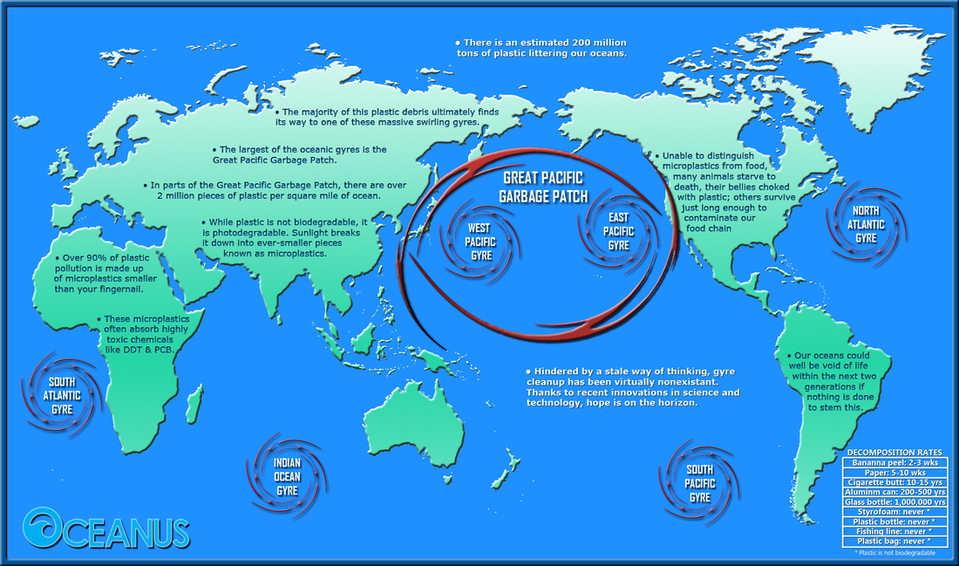
Animals get entangled in ocean plastics and they ingest it along with the toxics that adsorb to it. It has been estimated that each year plastic waste is killing one million seabirds, 100,000 marine mammals, large numbers of sea turtles and sharks, and countless fish. Nearly half of the world’s most important fish stocks for human consumption have been reported to contain plastic.
Microplastics, tiny fragments causing big problems. Microplastics are tiny fragments of plastic that are less than 5 mm in length. Some microplastics, like microbeads, are purposely manufactured while other microplastics are the result of the degradation of larger plastic debris. Ocean plastics eventually break down into microplastics, which have been found literally everywhere in the ocean where they have been looked for. On some beaches on the Big Island of Hawaii, as much as 15 percent of the sand is actually grains of microplastic. When consumed by marine organisms these microscopic pieces of plastic can cause physical damage and release toxins. Plastics have a natural affinity for toxicants and acts as a toxic conveyor belt, sponging up pollutants transferring it to everything that eats it.
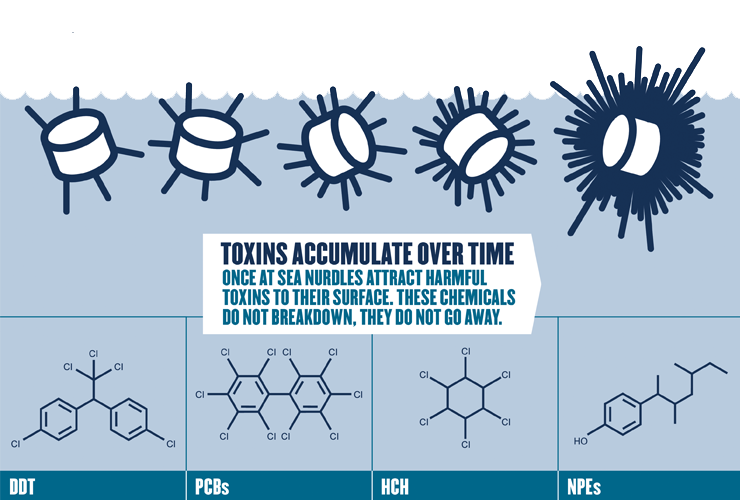
Plastics on our plates. Not only are marine organisms being directly impacted, humans may be impacted by consuming contaminated fish and shellfish. Research on the impacts of human consumption of microplastics through the food chain is growing but little is known about the impact on human health. Recent research conducted in the Salish Sea has shown that small plastics are widespread along shorelines and that filter feeding organisms like mussels, clams, and oysters are contaminated by plastics they have ingested from the surrounding waters.
What to do, what to do? Reduce your use of plastics, especially single use plastics! Adopt some “simple swaps” to reduce single use plastics in your life. Carry your own water bottle instead of using single-use plastic water bottles. Bring reusable shopping bags instead of using plastic grocery bags. Bring your own cutlery when you are eating away from home instead of relying on plastic cutlery. Use your reusable coffee cup instead of buying a single use cup. These simple habits can have a big impact when included in our daily routine. Plastics are all around us in our daily lives, so it can seem like a daunting task to reduce plastics in our lives. Just think of it as a journey to transition away from a “Throw Away” lifestyle to one that is better for our environment and health.
Sources:
Addressing Land-based Pollution
https://www.unenvironment.org/explore-topics/oceans-seas/what-we-do/addressing-land-based-pollution
Fact Sheet: Single Use Plastics
https://www.earthday.org/2018/03/29/fact-sheet-single-use-plastics/
Geyer, R., Jambeck, J.R., and Lavender Law, K. 2017. Production, use, and fate of all plastics ever made. Science Advances 19 Jul 2017. Vol. 3, no. 7, e1700782. DOI: 10.1126/sciadv.1700782 https://advances.sciencemag.org/content/advances/3/7/e1700782.full.pdf
Guess What’s Showing Up In Our Shellfish? One Word: Plastics
https://www.npr.org/sections/thesalt/2017/09/19/551261222/guess-whats-showing-up-in-our-shellfish-one-word-plastics
The Impact of Microplastics on Food Safety: the Case of Fishery and Aquaculture Products
http://www.fao.org/in-action/globefish/fishery-information/resource-detail/en/c/1046435/
Microplastics in Fisheries and Aquaculture
http://www.fao.org/3/a-i7677e.pdf
The Ocean Conference-Factsheet: Marine Pollution
https://sustainabledevelopment.un.org/content/documents/Ocean_Factsheet_Pollution.pdf
Planet or Plastic
https://www.nationalgeographic.com/environment/planetorplastic/
Plastic Bag Consumption Facts
https://conservingnow.com/plastic-bag-consumption-facts/
UNEP. 2018. Single-use plastics: A Roadmap for Sustainability. https://wedocs.unep.org/bitstream/handle/20.500.11822/25496/singleUsePlastic_sustainability.pdf?isAllowed=y&sequence=1
What are Microplastics
https://oceanservice.noaa.gov/facts/microplastics.html
1bag at a time
https://1bagatatime.com/learn/plastic-bags-petroleum/
The Skagit Plastic Reduction and Recycling Coalition is a partnership between Friends of Skagit Beaches, Skagit County Solid Waste, and the Washington Department of Ecology. We are working to educate Skagit County residents on the issues of plastic waste in the environment and involve them in taking action to avoid single-use plastics and recycle plastic right.
The Friends of Skagit Beaches Plastics Project is funded by a grant from the Washington Department of Ecology with additional support from Skagit County Solid Waste Division.
By accepting you will be accessing a service provided by a third-party external to https://skagitbeaches.org/

